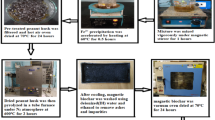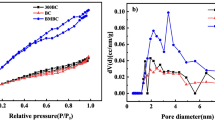Abstract
A novel magnetic bioadsorbent based on jute stick powder (MB-JSP) was synthesized with Fe2+ and Fe3+ solutions by in situ co-precipitation technique and applied for the elimination of Cr (VI) from aqueous solution. The adsorption capability of fresh jute stick powder (JSP) was also studied to compare with the magnetic bioadsorbent (MB-JSP). The characteristics of these bio-adsorbents were measured individually. The magnetic saturation of MB-JSP touched 14.25 emu/g which was sufficient for the separation of MB-JSP from aqueous solution. This magnetic bioadsorbent worked perfectly within a substantial pH range of 1–2. The Cr (VI) removal by MB-JSP was seamlessly supported by the Langmuir isotherm model (R2 = 0.997–0.999) and pseudo-second-order kinetic model (R2 = 0.994–0.995). The maximum capacity of Cr(VI) adsorption by MB-JSP and JSP were 47.125 and 30.422 mg/g, respectively at 303.15 K by Langmuir isotherm model. The regeneration experiment specified its merit of regeneration and firmness with the recovery efficiency of 90.17% and 80.23% for MB-JSP and JSP, respectively. It was observed by considering the results that the removal Cr(VI) ions was accomplished via the attraction between the opposite charges of different functional groups present on the adsorbents surface and ion exchange. Moreover, the process of removal was very effective and a rapid separation from aqueous solution was achieved.















Similar content being viewed by others
References
Agrawal, A., Pal, C., & Sahu, K. K. (2008). Extractive removal of chromium (VI) from industrial waste solution. Journal of Hazardous Materials.
Alemu, A., Lemma, B., Gabbiye, N., Tadele, M., & Teferi, M. (2018). Removal of chromium (VI) from aqueous solution using vesicular basalt: a potential low cost wastewater treatment system. Heliyon, 4(7), e00682.
Babel, S., & Kurniawan, T. A. (2003). Low-cost adsorbents for heavy metals uptake from contaminated water: a review. Journal of Hazardous Materials.
Ball, R., Mcintosh, A. C., & Brindley, J. (2004). Feedback processes in cellulose thermal decomposition: implications for fire-retarding strategies and treatments. Combustion Theory and Modelling, 8(2), 281–291.
Barakat, M. A., & Schmidt, E. (2010). Polymer-enhanced ultrafiltration process for heavy metals removal from industrial wastewater. Desalination.
Barrera-Díaz, C. E., Lugo-Lugo, V., & Bilyeu, B. (2012). A review of chemical, electrochemical and biological methods for aqueous Cr(VI) reduction. Journal of Hazardous Materials.
Bertagnolli, C., da Silva, M. G. C., & Guibal, E. (2014). Chromium biosorption using the residue of alginate extraction from Sargassum filipendula. Chemical Engineering Journal.
Bolong, N., Ismail, A. F., Salim, M. R., & Matsuura, T. (2009). A review of the effects of emerging contaminants in wastewater and options for their removal. Desalination coagulation/precipitation: Mechanisms and theory. Chemical Engineering Journal.
Gao, P., Chen, X., Shen, F., & Chen, G. (2005). Removal of chromium(VI) from wastewater by combined electrocoagulation- electroflotation without a filter. Separation and Purification Technology.
Ge, L., Wu, B., Li, Q., Wang, Y., Yu, D., Wu, L., et al. (2016). Electrodialysis with nanofiltration membrane (EDNF) for high-efficiency cations fractionation. Journal of Membrane Science.
Golbaz, S., Jafari, A. J., Rafiee, M., & Kalantary, R. R. (2014). Separate and simultaneous removal of phenol, chromium, and cyanide from aqueous solution by.
Hossain, M. M., & Abdulla, F. (2015). Jute production in Bangladesh: a time series analysis. Journal of Mathematics and Statistics, 11(3), 93–98.
Hyder, M. K. M. Z., & Ochiai, B. (2017). Synthesis of a selective scavenger for Ag(I), Pd(II), and Au(III) based on cellulose filter paper grafted with polymer chains bearing thiocarbamate moieties. Chemistry Letters, 46(4), 492–494.
Jaishankar, M., Tseten, T., Anbalagan, N., Mathew, B. B., & Beeregowda, K. N. (2014). Toxicity, mechanism and health effects of some heavy metals. Interdisciplinary Toxicology, 7(2), 60–72.
Jan, A. T., Azam, M., Siddiqui, K., Ali, A., Choi, I., & Haq, Q. M. R. (2015). Heavy metals and human health: mechanistic insight into toxicity and counter defense system of antioxidants. International Journal of Molecular Sciences, 16(12), 29592–29630.
Kongsricharoern, N., & Polprasert, C. (1995). Electrochemical precipitation of chromium (Cr6+) from an electroplating wastewater. Water Science and Technology.
Kozlowski, C. A., & Walkowiak, W. (2002). Removal of chromium(VI) from aqueous solutions by polymer inclusion membranes. Water Research.
Lin, C., Qiao, S., Luo, W., Liu, Y., Liu, D., Li, X., & Liu, M. (2014). Thermodynamics, kinetics, and regeneration studies for adsorption of Cr(VI) from aqueous solutions using modified cellulose as adsorbent. BioResources, 9(4), 6998–7017.
Mohanty, K., Jha, M., Meikap, B. C., & Biswas, M. N. (2006). Biosorption of Cr(VI) from aqueous solutions by Eichhornia crassipes. Chemical Engineering Journal, 117(1), 71–77.
Nemery, B. (1990). Metal toxicity and the respiratory tract. European Respiratory Journal, 3(2), 202–219.
Nguyen, T. A. H., Ngo, H. H., Guo, W. S., Zhang, J., Liang, S., Yue, Q. Y., et al. (2013). Applicability of agricultural waste and by-products for adsorptive removal of heavy metals from wastewater. Bioresource Technology, 148, 574–585.
Panda, G. C., Das, S. K., & Guha, A. K. (2009). Jute stick powder as a potential biomass for the removal of congo red and rhodamine B from their aqueous solution. Journal of Hazardous Materials, 164(1), 374–379.
Park, D., Yun, Y. S., & Park, J. M. (2008a). XAS and XPS studies on chromium-binding groups of biomaterial during Cr(VI) biosorption. Journal of Colloid and Interface Science, 317(1), 54–61.
Park, D., Yun, Y. S., Kim, J. Y., & Park, J. M. (2008b). How to study Cr(VI) biosorption: use of fermentation waste for detoxifying Cr(VI) in aqueous solution. Chemical Engineering Journal.
Petruzzelli, D., Passino, R., & Tiravanti, G. (1995). Ion exchange process for chromium removal and recovery from tannery wastes. Industrial and Engineering Chemistry Research.
Raji, C., & Anirudhan, T. S. (1998). Batch Cr(VI) removal by polyacrylamide-grafted sawdust: kinetics and thermodynamics. Water Research, 32(12), 3772–3780.
Saha, B., & Orvig, C. (2010). Biosorbents for hexavalent chromium elimination from industrial and municipal effluents. Coordination Chemistry Reviews, 254(23–24), 2959–2972.
Saha, R., Nandi, R., & Saha, B. (2011). Sources and toxicity of hexavalent chromium. Journal of Coordination Chemistry, 64(10), 1782–1806.
Singh, R., Gautam, N., Mishra, A., & Gupta, R. (2011). Heavy metals and living systems: an overview. Indian Journal of Pharmacology, 43(3), 246–253.
Song, W., Gao, B., Xu, X., Wang, F., Xue, N., Sun, S., et al. (2016). Adsorption of nitrate from aqueous solution by magnetic amine-crosslinked biopolymer based corn stalk and its chemical regeneration property. Journal of Hazardous Materials, 304, 280–290.
Song, R., Murphy, M., Li, C., Ting, K., Soo, C., & Zheng, Z. (2018). Current development of biodegradable polymeric materials for biomedical applications. Drug Design, Development and Therapy, 24(12), 3117–3145.
Talokar, A. Y. (2011). Studies on removal of chromium from waste water by adsorption using low cost agricultural biomass as adsorbents. International Journal of Advanced Biotechnology and Research, 2(4), 452–456.
Uddin, M. N., Alam, J., & Naher, S. R. (2018). Biosorption of Cr(III) from aqueous solution using an agricultural by-product jute stick powder: equilibrium and kinetic studies. European Journal of Chemistry, 9(3), 202–212.
Wang, H., Xu, X., Ren, Z., & Gao, B. (2016). Removal of phosphate and chromium(VI) from liquids by an amine-crosslinked nano-Fe3O4 biosorbent derived from corn straw. RSC Advances, 6(53), 47237–47248.
Yin, K., Lo, I. M. C., Dong, H., Rao, P., & Mak, M. S. H. (2012). Lab-scale simulation of the fate and transport of nano zero-valent iron in subsurface environments: aggregation, sedimentation, and contaminant desorption. Journal of Hazardous Materials, 15(227–228), 118–125.
Acknowledgments
The authors acknowledge the research project code: CUET/DRE/2015-16/CHEM/006 of Chittagong University of Engineering & Technology, Chattogram-4349, Bangladesh.
Author information
Authors and Affiliations
Corresponding author
Ethics declarations
Conflict of Interest
The authors declare that they have no conflict of interest.
Additional information
Publisher’s Note
Springer Nature remains neutral with regard to jurisdictional claims in published maps and institutional affiliations.
Rights and permissions
About this article
Cite this article
Rhaman, M.M., Karim, M.R., Hyder, M.M.Z. et al. Removal of Chromium (VI) from Effluent by a Magnetic Bioadsorbent Based on Jute Stick Powder and its Adsorption Isotherm, Kinetics and Regeneration Study. Water Air Soil Pollut 231, 164 (2020). https://doi.org/10.1007/s11270-020-04544-8
Received:
Accepted:
Published:
DOI: https://doi.org/10.1007/s11270-020-04544-8




